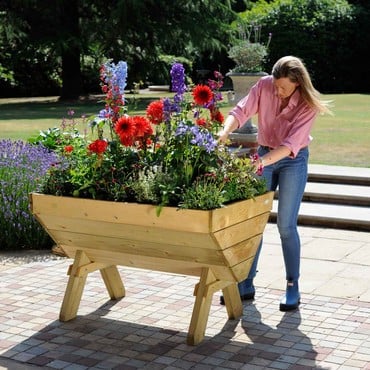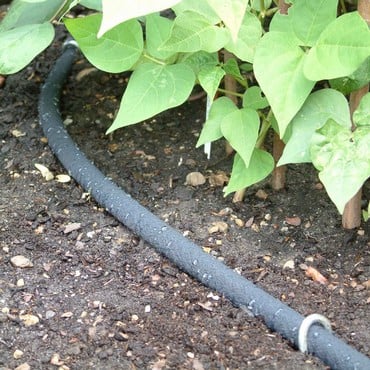Growing in raised planters is a real boom area in gardening right now and it's little wonder when you realise just how easy it can be and how many delicious vegetables you can cram into a small space. Let's take a look at how one of our attractive Manger Raised Planters - all 8ft of it - can transform a barren patio into a vegetable oasis.
 If you’re intending to use a water butt as the water source for your Manger Raised Planter then the very best option to distribute this stored water is the soaker hose. Made from re-cycled rubber – I believe car tyres are used – the soaker hose is porous throughout its entire length and more importantly, it operates at a low water pressure – ideal for your planned set-up with the water butt. The soaker hose can easily be cut to the desired size with a pair of sharp scissors and being of the same diameter as a standard hosepipe (0.5”), is easily connected to the latter – this is important when running a soaker hose from a water butt or mains tap as the hose will seep water over its entire length, so depending on the proximity of the water butt to your manger, you may need to introduce a piece of hosepipe to the installation.
If you’re intending to use a water butt as the water source for your Manger Raised Planter then the very best option to distribute this stored water is the soaker hose. Made from re-cycled rubber – I believe car tyres are used – the soaker hose is porous throughout its entire length and more importantly, it operates at a low water pressure – ideal for your planned set-up with the water butt. The soaker hose can easily be cut to the desired size with a pair of sharp scissors and being of the same diameter as a standard hosepipe (0.5”), is easily connected to the latter – this is important when running a soaker hose from a water butt or mains tap as the hose will seep water over its entire length, so depending on the proximity of the water butt to your manger, you may need to introduce a piece of hosepipe to the installation.
On most cultivated soils and especially so in raised beds, the water will seep out up to 50cm (19”) either side of the soaker hose and extending your system at a later date is also relatively simple and in-expensive. Two pieces of soaker hose can be easily joined in the same way you’d join a hosepipe.
The soaker hoses are supplied in 15, 30 and 50m kits and although even the smallest length is going to be far in excess of the quantity you need to irrigate the manger (8ft/2.5m run), this versatile watering pipe can be used in plenty of other situations in the garden so it won’t go to waste! It’s ideal in vegetable plots and herbaceous beds and borders and can even be buried in the lawn to keep the grass green – and connecting up to a hosepipe is simple, as I’ve said before.
You might have been considering raised bed irrigation kits and micro irrigation systems and although they are extremely efficient and, like the soaker hose, deliver water to the soil surface they do require mains water pressure to operate. This is fine when your water butt is full but as the water level drops, so does the head of water and thus the water pressure.
Ideally, you want the tap of the water butt to be level with the planting level in the manger as a butt at ground level will require the water to be pushed up to the manger. For your own peace of mind, you might want to check this with a section of hosepipe before purchasing the soaker hose so you’ll know how the system will function.
Finally, the question of how many vegetable plants you can fit into the 8ft Manger Planter. It’s impossible to give you a quantity but it’s important to remember that in a compacted space like planters and raised beds, the recommended plant spacing goes out the window! You can plant much closer together and create a micro-climate where plants will benefit, weeds are suppressed and soil-borne diseases – because the compost/soil you are growing in is replaced or at least replenished each year – find it difficult to thrive. Because you are planting many different crops in a small space, pests can also struggle to get a foothold; growing onions next to carrots, for example, helps deter carrot fly as they don’t like the odour of alliums!
The general rule general rule for planting is the closer you grow your vegetables, the smaller they will be; onions and beetroot are prime examples where those destined for pickling are planted around 5cm apart, half the usual spacing. Root crops and Leeks and Onions are the easiest to manage (parsnips, carrots, beetroot, onions and leeks) and simply halve the recommended spacing for all these crops. We would certainly suggest you plant the shallow rooting strawberries around the edge of the manger and gradually work your way to the centre where root crops such as carrots and even the odd potato plant will flourish in the deeper soil and basically then aim to cover all the soil.





























